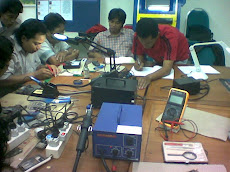Memasang Kabel LAN UTP (Unshielded Twisted Pair) untuk jaringan mudah-mudah susah....
yang perlu disediakan RJ45, Kabel LAN biasanya Belden(merk yang umum digunakan), Tang klip (Chrim), LAN Tester.

Kabel LAN Chrim (Tang Klip)

RJ45(Cross Adapter) RJ45
Lan Tester
Kabel UTP ada beberapa kategori , kategori 1 - 7 yang sering digunakan untuk LAN biasanya kategori 5 atau sering disebut cat-5. Berikut ini kegunaan dari kabel kategori 1 - 7 diambil dari wikipedia.
cat 1: sebelumnya dipakai untuk POST (Plain Old Telephone Service) telephone dan ISDN.
cat 2: dipakai untuk token ring network dengan bw 4mbps
cat 3: dipakai untuk data network dengan frequensi up to 16Mhz dan lebih populer untuk pemakaian 10mbps
cat 4: Frequensi up to 20Mhz dan sering dipakai untuk 16mbps token ring network.
cat 5: Frequensi up to 100Mhz dan biasa dipakai untuk network dengan kecepatan 100Mbps tetap kemungkinan tidak cocok untuk gigabyte ethernet network.
cat 5e: Frequensi dan kecepatan sama dengan cat-5 tetapi lebih support gigabyte ethernet network.
cat 6: Memiliki kecepatan up to 250Mbps atau lebih dari dua kali cat-5 dan cat-5e
cat 6a: Kabel masa depan untuk kecepatan up to 10Gbps
cat 7: di design untuk bekerja pada frequensi up to 600Mhz.
Ada dua Tipe pemasangan UTP yaitu : Tipe Cross dan Straight.
dalam pemasangan UTP yang paling penting adalah kabel urutan 1,2,3,6, sedangkan 4,5,7,8 tidak untuk transfer data.



Tipe Straight
ini paling mudah yang penting antara ujung yang satu dengan yang lain harus sama (sewarna).
standarnya adalah berwarna :
- oranye muda
- oranye tua
- hijau muda
- biru muda
- biru tua
- hijau tua
- coklat muda
- coklat tua

Tipe Cross/Silang :
Cross cable biasa dipakai untuk koneksi dari PC to PC / PC to Router, Pokoknya semua koneksi dari alat yang biasanya koneksi melalui switch atau hub tetapi dipasang secara langsung. Berikut ini contoh posisi kabel dalam kondisi crossover.
model ini hanya menyilangkan antara ujung yang satu dengan yang lain.
1 ------> 3
2 ------> 6
3 ------> 1
6 ------> 2
sebagai berikut detailnya :
ujung yang pertama
- oranye muda
- oranye tua
- hijau muda
- biru muda
- biru tua
- hijau tua
- coklat muda
- coklat tua
- hijau muda
- hijau tua
- orange muda
- biru muda
- biru tua
- orange tua
- coklat muda
- coklat tua
 Re: UTP - Standard TIA 568A-B
Re: UTP - Standard TIA 568A-BNambahin dikit ajah, soal standar bukan tidak akan menimbulkan masalah jika tidak di ikuti? Afaik, standar itu dibuat sebagai panduan sekaligus kontrol performance suatu alat, dlm hal ini kabel UTP. Untuk standar yg seharusnya di ikuti sudah di atur dlm standar TIA 568A dan 568B, untuk kabel 'straight' dianjurkan untuk menggunakan 568B sedangkan kabel 'cross' satu sisi 568A dan sisi lain 568B.
UTP 568A dan 568B
Pemasangan UTP tidak mengikuti aturan Standar bukan tidak akan menimbulkan masalah. Standar itu dibuat sebagai panduan sekaligus kontrol performance suatu alat, dlm hal ini kabel UTP. Untuk standar yg seharusnya di ikuti sudah di atur dlm standar TIA 568A dan 568B, untuk kabel 'straight' dianjurkan untuk menggunakan 568B sedangkan kabel 'cross' satu sisi 568A dan sisi lain 568B. Ketika mengupgrade basis 10Mbps ke 100Mbps. apabila kita memasang UTP dengan tidak mengikuti Standar TIA sering menjadi masalah.
Cara Pemasangannya :
 Kupas kabel LAN, bisa dengan Chrip Tools(TangKlip) di bagian untuk pengupas Kabel dan urutkan warna kabel yang akan kita pasang.
Kupas kabel LAN, bisa dengan Chrip Tools(TangKlip) di bagian untuk pengupas Kabel dan urutkan warna kabel yang akan kita pasang. Ratakan Kabel yang telah terkelupas dengan cara dipotong, di Chrim tools juga ada bagian untuk memotong kabel.
Ratakan Kabel yang telah terkelupas dengan cara dipotong, di Chrim tools juga ada bagian untuk memotong kabel. Ratakan Kabelnya sebelum dimasukan kedalam RJ45.
Ratakan Kabelnya sebelum dimasukan kedalam RJ45. Masukkan kabel yang tadi sudah diurutkan kabelnya dan sudah diratakan.
Masukkan kabel yang tadi sudah diurutkan kabelnya dan sudah diratakan. Tekan Kabel kedalam hingga kabel tersebut rata diujung pin.
Tekan Kabel kedalam hingga kabel tersebut rata diujung pin. Tekan Pin RJ dengan Chrim Tools.
Tekan Pin RJ dengan Chrim Tools.Lalu Tes kabel dengan Tester LAN, pastikan semua Lampu menyala semua dengan baik.
Untuk Straight Lampu Tester akan menyala secara bersamaan.
Untuk Cross Lampu akan menyala secara silang, yaitu diurutan 1,2,3,6 (A) dengan 3,6,1,2 (B).
berarti sudah benar dan siap digunakan.


